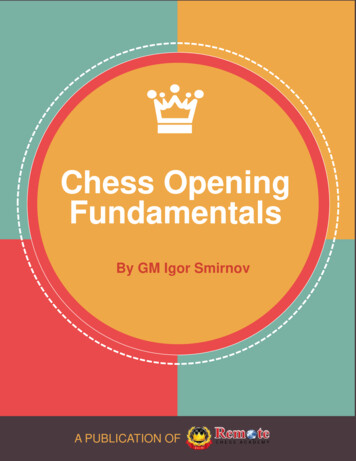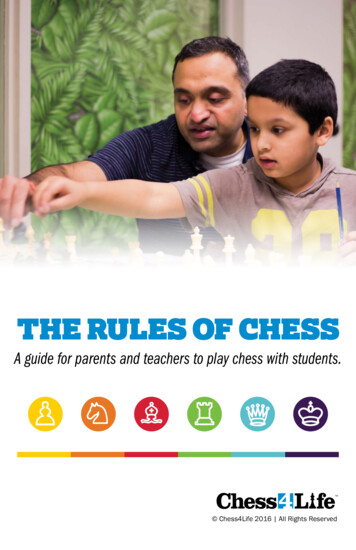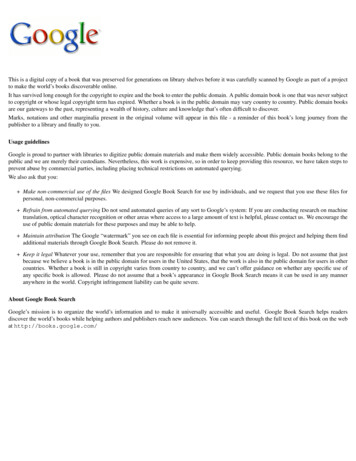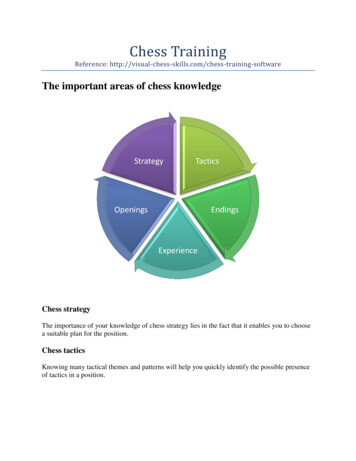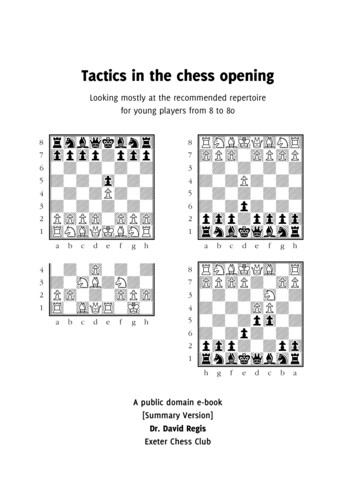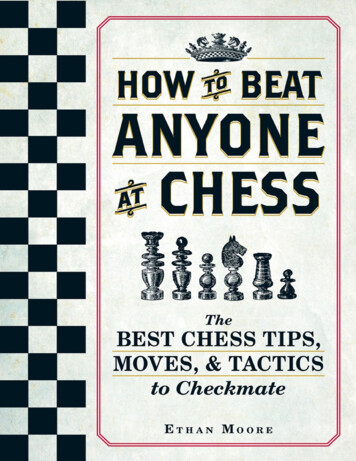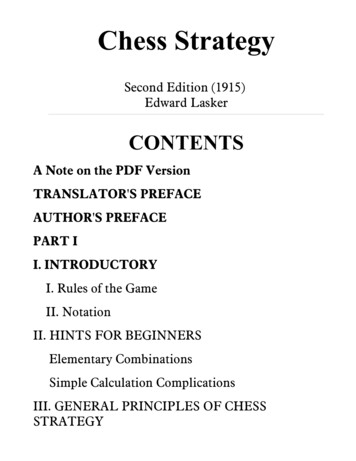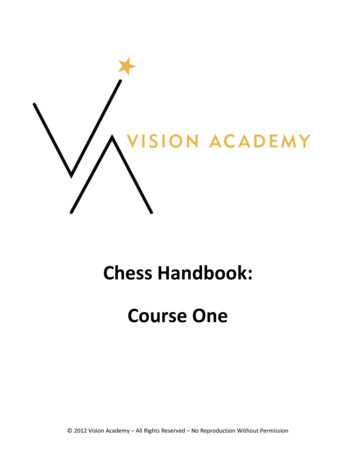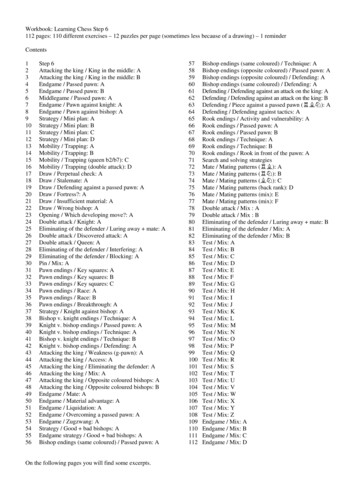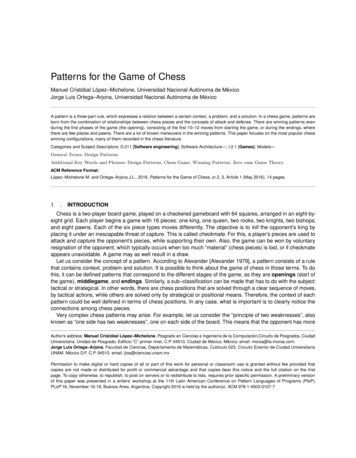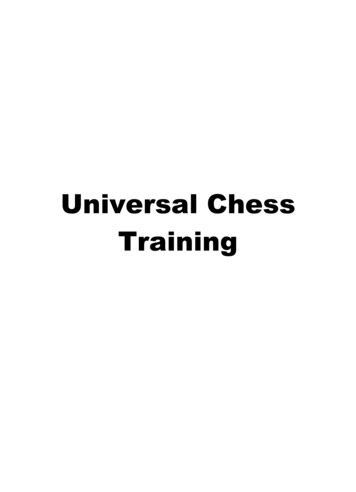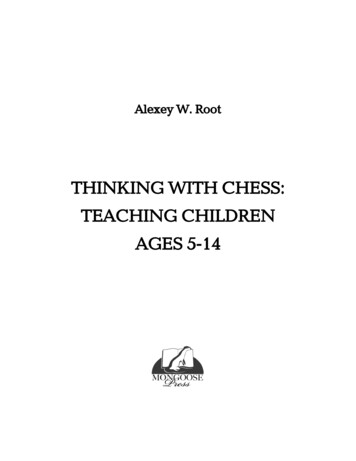
Transcription
Alexey W. RootTHINKING WITH CHESS:TEACHING CHILDRENAGES 5-141
2012 Alexey W. RootAll rights reserved. No part of this book may be reproducedor transmitted in any form by any means, electronic ormechanical, including photocopying, recording, or by aninformation storage and retrieval system, without writtenpermission from the Publisher.Publisher: Mongoose Press1005 Boylston Street, Suite 324Newton Highlands, MA BN 978-1-936277-36-0Library of Congress Control Number: 2012938729Distributed to the trade by National Book Networkcustserv@nbnbooks.com, 800-462-6420For all other sales inquiries please contact the publisher.Edited by Jorge AmadorLayout: Andrey ElkovCover Design: Kaloyan NachevPrinted in ChinaFirst English edition0987654321
CONTENTSForeword by Kevin O’Connell. 6CHAPTER 1: Overview . 8Benefits of Chess .12Chess Equipment .14Multiple Ages .15CHAPTER 2: Rules of Chess .18Chessmen .18Special Rules .22Check, Checkmate, and Stalemate .24CHAPTER 3: Pieces, Pawns, and Squares .26Classify .26Pattern Recognition .30CHAPTER 4: Bishop and Rook .33Lines .33Decode .35CHAPTER 5: Queen and King .38Choices .38Game Theory .41CHAPTER 6: Pawn and Knight .44Create .44Predict .46CHAPTER 7: Endgame Checkmates .48Instruction .48Puzzles.51CHAPTER 8: Back-Rank and Smothered Checkmates .53Instruction .53Puzzles.564
CHAPTER 9: Doubled and Discovered Checkmates .59Instruction .59Puzzles.60CHAPTER 10: Clubs, Competitions, and Camps.62Clubs .62Tournaments .62Internet .63Chess Camps .64APPENDIX A: Solutions .72APPENDIX B: References.75APPENDIX C: Brooklyn Castle .785
- - - - FOREWORD - - - Too often we teach children how thepieces move and then immediately getthem playing (or trying to play) full gameswith all the pieces. The problem can bemade worse by throwing in a lecture aboutthe Sicilian or Spanish for good measure.What we really should do is to get thechildren involved in absorbing play usingthe chessmen and the chessboard. Wemust avoid “talking down” to them and atthe same time refrain from setting themtasks that are too complicated for theirchess understanding. I believe this book isan excellent attempt at providing what weneed.I have often been asked, “What exactlyshould I do?” by those undertakingchess teaching or coaching. The detailedtimetable of a five-day chess camp inChapter 10 will be a boon to thosewanting answers. The reader will findmany other useful topics and answers toother practical questions. Not only that,but the reader is assured of the fact thatthe challenges and puzzles have receivedthorough testing, not only at the hands of6children, but some also – unusually – byexperienced educators, chess teachers,chess masters, and chess trainers.When I accepted an invitation tothe Second Koltanowski InternationalConference on Chess and Education inDallas in November 2011, to presentthe story of chess in schools in Turkeyand how the World Chess Federation(FIDE) is working to build on that asa model for developing chess in schoolsaround the world, I anticipated findingthe other presentations of interest.However, I was expecting that to be apassive interest and I was somewhatsurprised when Alexey brought out theboards and sets during the presentationshe shared with Dr. Joseph Eberhard.All those in the room, attendees andpresenters alike, were paired off withtheir neighbors, in my case withpresenter David Barrett. We were soonall wrapped up in two of the challenges(Classify and Game Theory) thatare included in this book. During theprevious two months, the challenges and
puzzles had been tested with childrenduring Dr. Root’s chess classes.I find it remarkable (and remarkablygood) that the very same challenges canbe enjoyed by one and all. Many are thechess books (most of them best forgotten)that have laid claim to being appropriatefor players of all ages and levels, but thesechallenges genuinely meet that claim.The Classify challenge was hugelyenjoyable. David and I came up with avariety of different classifications. But itwas the Game Theory challenge, in whichchildren have fun figuring out whetherone’s best strategy for achieving castlingis to aim for it directly or to disrupt theopponent’s plans first, that was themost intriguing. You can see our effortin Appendix A. The stipulation was forkingside castling; nonetheless, I claim tobe better in the final position because afterany move of the b8-knight, although I willnot be able to castle kingside, queensidecastling two moves later is unstoppable!We were involved and motivated. I’msure this material will do the same forchildren.FIDE Senior Trainer Kevin O’ConnellApril 20127
Bishop and RookMaterialsThirty sticky notes per child. Each stickynote should be slightly smaller than asquare on the chessboard. Set and boardfor every pair of children. Demonstrationboard (or equivalent) and sticky notes forthe teacher are optional.Spelling words should be at an appropriate level for the children playing the Decode challenge. Choose words studied inLanguage Arts or words from chess. Thechess list might include board, file, rank,diagonal, win, lose, draw, move, rook,king, bishop, pawn, queen, knight, capture, castle, check, checkmate, and stalemate.Figure 4.2.Children playing the Lines challenge.Public Library class playing the Lineschallenge.DECODEObjectivesChildren write letters on sticky notes.Each child places the letters on a boardsuch that another child’s chessman maycapture one letter per turn. Children’schessmen capture letters. Children formwords from the captured letters.ProcedurePass out sets, boards, and sticky notesto pairs of children. It is optional to placesticky notes on the demonstration board toshow Figure 4.3. Figure 4.3 shows a possible starting position of the Decode challenge. The word “queen” can be decodedafter the letters are captured by the whiterook. Point out that the rook on f3 needsto capture a letter on each move. So therook capturing on f5-f7-c7-c5-a5 works,but the rook capturing on f5-c5-a5 leavesit stuck on a5 with nothing to capture onits next move. Sticky notes may be placedletter-side up (as in Figure 4.3) or letterside down.35
CHAPTER 4XIIIIIIIIY8- - - - 0en7 - - - -06- - - - 05 - - - -0equ4- - - - 03 - - R -02- - - - 01 - - - -0xabcdefghyFigure 4.3.Decode the word “queen.”Within each pair of children, the firstchild holds a list of spelling words (or thechess words listed under Materials). He orshe decides which word to spell, letter byletter, on sticky notes.The first child places the sticky notes onthe board. The word’s letters should beout of order, but with each letter a rook’smove away from the previous letter. Thefirst child positions a rook on the boardsuch that it can capture one letter permove.The second child uses the rook to capture each letter. The sticky notes don’tmove from their squares. After repeatedrook captures, the second child has collected all the sticky notes. The secondchild unscrambles the captured letters toreveal a word. The first child confirmsthat the word is the intended one. If a36new word has been created instead, thatis a “Eureka!” insight about how lettersmay spell more than one word. Then it isthe second child’s turn to take the spelling list and some new sticky notes. Thesecond child writes letters on the notesand places them on the board. The firstchild will repeat the rook captures andword decoding.As written, this challenge reinforceshow the rook captures. If desired, chessmen other than the rook can be used forthis challenge. Place the letters so that theselected chessman captures one sticky noteFigure 4.4. Girl placing lettersfor the Decode challenge.
Bishop and Rookper move. Figure 4.4 shows a 6-year-oldgirl placing letters a diagonal move apartfrom each other.EvaluationAs children play the Decode challenge,monitor to make sure they write one letter per sticky note. Each child could be thedecoder twice before the pair switches toplaying chess games for fun.37
ture, castle, check, checkmate, and stale-mate. Procedure Pass out sets, boards, and sticky notes to pairs of children. It is optional to place sticky notes on the demonstration board to show Figure 4.3. Figure 4.3 shows a pos-sible starting position of the Decode chal-lenge. The word “queen” can
